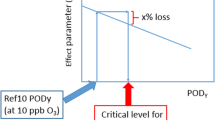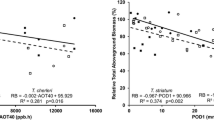Abstract
An ozone deposition module is currently being developed which will allow the estimation of stomatal fluxes of ozone into a number of vegetation types. This model is designed to be linked into a regional chemical-transport model for use within the European Monitoring and Evaluation Programme (EMEP), to provide information on possible risks to vegetation across Europe. This paper investigates the sensitivity of this model to some of the important input parameters, for two land-cover classes (temperate coniferous forests, temperate cereals). Of the factors contributing to the stomatal conductance considered within this study, those controlling soil moisture seem to be the biggest source of uncertainty. As ozone damage is believed to be driven by flux into the leaf rather than by ambient concentrations, this study suggests that flux modelling may be a practical alternative to the use of the AOT40 concept which is currently used to guide assessments of vegetation risk.
Similar content being viewed by others
References
Emberson, L., D. Simpson, J.-P. Tuovinen, M. R. Ashmore and H. M. Cambridge: 2000, 'Towards a model of ozone deposition and stomatal uptake over Europe'. Norwegian Meteorological Institute, Oslo, Norway, EMEP MSC-W Note 6/2000; Available as PDF at http://www.emep.int.
Emberson., L. D., M. R. Ashmore, H. M. Cambridge, D. Simpson and J.-P. Tuovinen: 2000a, 'Modelling stomatal ozone flux across Europe', Environ. Pollut. 109(3), 403–414.
Fuhrer, J.: 2000, 'Introduction to the special issue on ozone risk analysis for vegetation in Europe', Environ. Pollut. 109, 359–360.
Fuhrer, J., L. Skärby and M. Ashmore: 1997, 'Critical levels for ozone effects on vegetation in Europe', Environ. Pollut. 97, 91–106.
Garratt, J.: 1992, The atmospheric boundary layer, Cambridge, England: Cambridge University Press.
Iqbal, M.: 1983, An introduction to solar radiation, Ontario: Academic Press.
Jakobsen, H. A., J. E. Jonson and E. Berge: 1997, 'The multi-layer Eulerianmodel: Model description and evaluation of transboundary fluxes of sulphur and nitrogen for one year', EMEP/MSC-W Report 2/97, The Norwegian Meteorological Institute, Oslo, Norway.
Jarvis, P. and K. McNaughton: 1986, 'Stomatal control of transpiration: scaling up from leaf to region', Adv. Ecol. Res. 15, 1–49.
Jones, H.: 1992, Plants and microclimate. A quantitative approach to environmental plant physiology. Cambridge University Press. 2nd edition.
Jonson, J., L. Tarrasó n and J. Sundet: 1999, 'Calculation of ozone and other pollutants for the summer 1996', Environ. Manag. Health 10, 245–257.
Martin, M. J., P. K. Farage, S.W. Humphries and S. P. Long: 2000, 'Can the stomatal changes caused by acute ozone exposure be predicted by changes occurring in the mesophyll? A simplification for models of vegatation response to global increase in tropospheric elevated ozone episodes'. Austr. J. Plant Physiol. 27, 211–219.
Mintz, Y. and G. Walker: 1993, 'Global fields of soil moisture and land surface evapotranspiration derived from observed precipitation and surface air temperature', J. Appl. Meteorol. 32, 1305–1334.
Sandnes Lenschow, H. and S. Tsyro: 2000, 'Meteorological input data for EMEP/MSC-W air pollution models', Technical Report EMEP MSC-W Note 2/98, The Norwegian Meteorological Institute, Oslo, Norway.
Seland, O., A. van Pul, A. Sorteberg and J.-P. Tuovinen: 1995, 'Implementation of a Resistance Dry Deposition Module and a Variable Local Correction Factor in the Lagrangian EMEP Model', Technical Report EMEP Note 2/95, EMEP MSC-W, Norwegian Meteorological Institute.
Simpson, D., J. Altenstedt and A. Hjellbrekke: 1998, 'The Lagrangian oxidant model: status and multi-annual evaluation', in EMEP MSC-W Report 2/98, Part I Transboundary photooxidant air pollution in Europe. Calculations of tropospheric ozone and comparison with observations. Norwegian Meteorological Institute, Oslo, Norway.
Simpson, D., J.-P. Tuovinen, L. Emberson and M. Ashmore: 2001, 'Characteristics of an ozone deposition module', Water, Air, Soil, Pollut.:Focus 1, 253–262.
Sofiev, M. and J.-P. Tuovinen: 2001, 'Factors determining the robustness of AOT40 and other ozone exposure indices', Atmos. Environ. 35, 3521–3528.
Tuovinen, J.-P.: 2000, 'Assessing vegetation exposure to ozone: properties of the AOT40 index and modifications by deposition modelling', Environ. Pollut. 109, 361–372.
Tuovinen, J.-P., D. Simpson, T. N. Mikkelsen, L. D. Emberson, M. R. Ashmore, M. Aurela, H. M. Cambridge, M. F. Hovmand, N. O. Jensen, T. Laurila, K. Pilegaard and H. Ro-Poulsen: 2001, 'Comparisons of measured and modelled ozone deposition to forests in Northern Europe', Water, Air, Soil, Pollut.:Focus 1, 263–274.
Author information
Authors and Affiliations
Corresponding author
Rights and permissions
About this article
Cite this article
Simpson, D., Tuovinen, JP., Emberson, L. et al. Characteristics of an ozone deposition module II: Sensitivity analysis. Water, Air, & Soil Pollution 143, 123–137 (2003). https://doi.org/10.1023/A:1022890603066
Issue Date:
DOI: https://doi.org/10.1023/A:1022890603066




